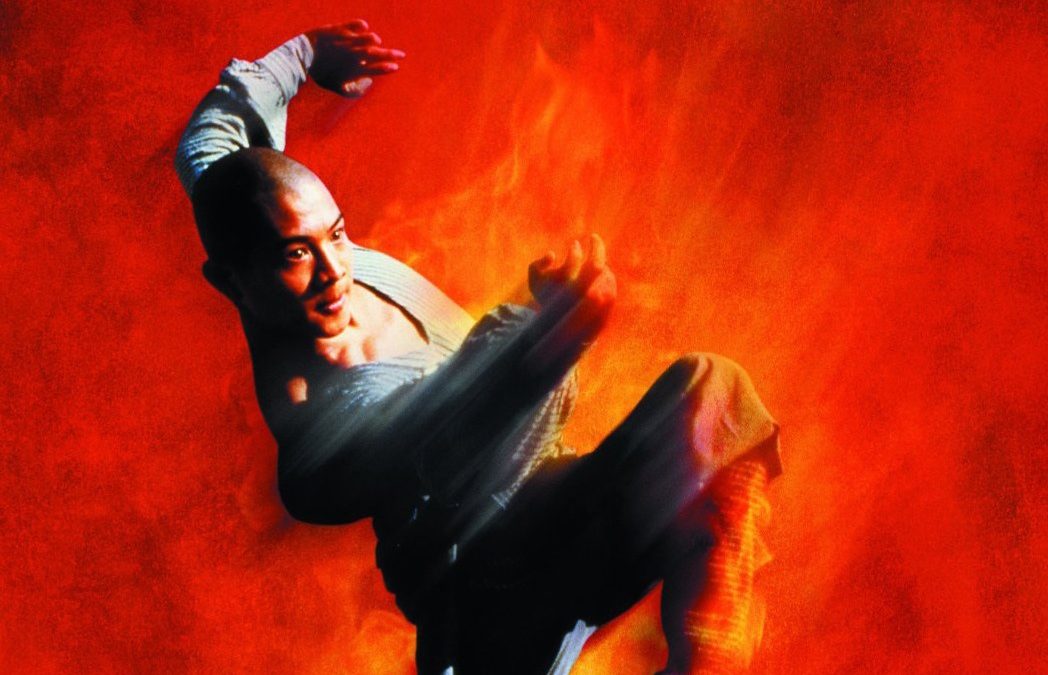Jet Li is inarguably one of the most iconic Chinese film stars of his generation. Be it through western action flicks like Romeo Must Die and Kiss Of The Dragon, or eastern classics like Hero or the Once Upon A Time In China series, Li brought his distinctive martial arts skills to the world, made his mark on cinema and amassed a huge, passionate fanbase. As part of our monthly martial arts features, we’re taking a look back at the films that launched Li’s movie career – the Shaolin Temple series.
The first Shaolin Temple film began filming in 1979 but wasn’t completed until 1981. Its director Cheung Sing-Yim initially cast Chinese opera performers but soon decided that teaching fighters to act was easier than teaching actors to fight, so he wiped the slate clean and recast the movie using real wushu champions. As part of the Chinese National Wushu Team, Jet Li (or Li Lianjie as he was known then) was already a famous athlete, but he’d never acted before. Besides Li, the principal cast featured mantis boxing expert Yue Hoi, drunken sword master Yu Cheng-Hui and young wushu boxing champ Woo Gin-Keung.
This was unusual for a Hong Kong funded film, to have not just a Mainland-born director but an almost entirely Chinese cast. Even more unusual was that Sing-Yim wanted to shoot it on location in China, at the actual Shaolin Temple in Luoyang. This wasn’t the first film ever to be shot at the Temple (Real Kung Fu Of Shaolin is an interesting Mainland oddity from 1980 if you like your martial arts deep cuts) but certainly the first on anything like this scale.
The plot is pretty straightforward and based loosely on a wall painting in the Temple. Jet Li is Chen Yuan, the son of a legendary fighter killed by an evil warlord, during a change of dynasties. While rebels are rounded up for the slaughter, Chen runs off and finds himself at the door of Shaolin Temple. He’s on the verge of death so the monks take a gamble that if he recovers, they’ll welcome him in. Miraculously, he lives and begins his Shaolin training, eager to take revenge for his father’s murder. However, he soon finds this thirst for vengeance goes against the teachings of the Buddha and is torn between his devotion and his emotion.
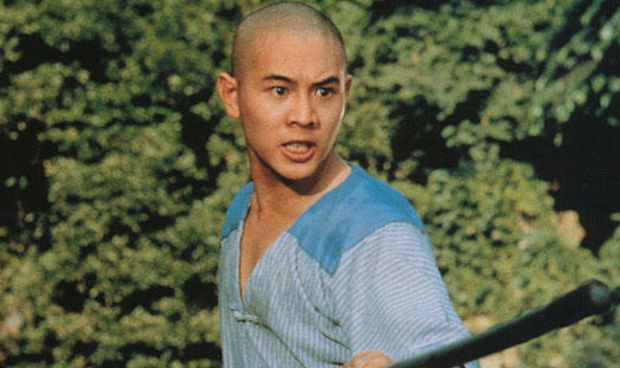
Looking at it now, Shaolin Temple’s story suffers from some very episodic structuring. It shifts tone from comedy to action a lot in the first half and the comedy is particularly broad and tasteless, even for the genre, mostly involving actual animal cruelty and simulated animal cruelty. At one point, Li’s character accidentally kills his love interest’s dog, then cooks and eats it, sharing the meat with the monks, and this is portrayed as being quite quaint and amusing!
HOWEVER, and it’s a big however, the martial arts are truly something to write home about. With the rare treat of having so many real wushu champions in the cast, the fights are authentic, low on editing tricks and high on insane skills. Having them take place on actual Shaolin cobbles generates a real thrill as well. It’s something you’ve not seen before and should give even jaded kung fu fans the goosebumps.
When the film hit screens across China in 1982, it was such a colossal hit that it reignited an interest in Shaolin Temple itself (which had been closed down during China’s cultural revolution and didn’t even have an active abbot at the time). Suddenly, there was so much enthusiasm for the Temple that apparently the Chinese government issued a notice to Mainland children, urging them to stay in school and not run off to become monks!
A smash on this level demanded a sequel so Cheung Sing-Yim got to work quickly and made Shaolin Temple 2: Kids From Shaolin (1984). Rather than continue the story, he reunited the main cast in an American Horror Story style, casting them as new characters in an unrelated story set in a different time and place.
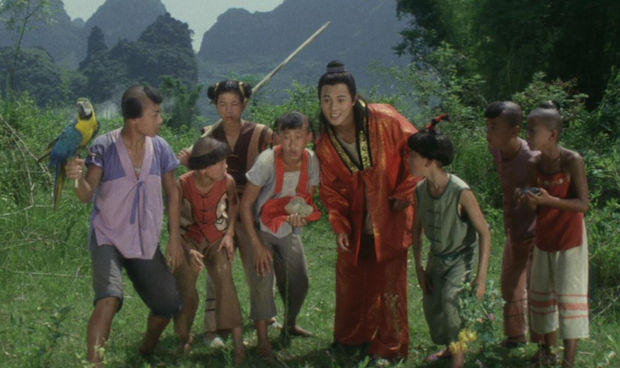
Now it’s the Ming Dynasty and there are two rural families, the Dragon Family (whose children are all boys) and the Phoenix Family (whose children are all girls) who live on farms with a river between them. Dragons learn only Shaolin kung fu. Phoenixes learn the Wu Tang sword technique. There’s obviously a rivalry between the two families but, at the same time, with a bunch of pubescent teens involved, a little bit of romance. Bizarrely, we’re told most of this via the medium of song and a Disney-style animation sequence…
There are a few other songs in the film too, some sung by the cast. In fact, for the most part, Shaolin Temple 2 plays like a Chinese take on Seven Brides For Seven Brothers. In addition to the songs there’s verdant scenery, light romance and more comedy hijinks than fighting. However, there is a team of evil bandits lurking in the background, plotting to pillage Phoenix Village and kidnap the women… so you can work out where the story goes. Will the Phoenixes and Dragons forget their differences and combine the powers of Shaolin and Wu Tang, to defeat the bandits? You’ll find out!
As weird as it may sound, it’s pretty entertaining stuff. Considering the cast were assembled in the first film for their wushu skills not their acting ability, they’re given a LOT of acting to do here and it works. Jet Li demonstrates he was born for the screen and brings a real romantic chemistry to his scenes with soon-to-be-real-life-wife Wong Chau-Yin (also a fighter in Li’s wushu team). It’s a breezy, cute adventure that’s maybe a touch heavy on little kid antics but not short on charm.
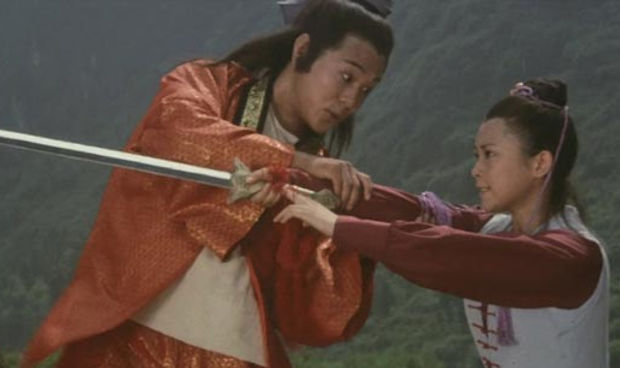
Eventually things do kick off, and the final fifteen minutes are a maelstrom of high octane brawling that includes a wider variety of melee weapons than I can ever recall seeing and an absolutely ouuuuuuuuch-inducing finishing move to end things with a bang. And, just like anyone who’s played International Karate Plus can tell you, trouser-splitting jokes are always funny.
As a result, Kids From Shaolin was another success and in 1986, a third Shaolin Temple film appeared. Although Shaolin Temple 3 (aka Martial Arts Of Shaolin) was shot on the Mainland with most of the old cast returning, this was a proper Hong Kong production with the Shaw Brothers producing and the legendary Lau Kar-Leung in the director’s seat. No stranger to Shaolin, having directed the 36th Chamber Trilogy, Kar-Leung slots right in but puts his own spin on the series. It’s particularly awesome to see locations at the Great Wall and The Forbidden City put to such stunning use. So many Shaws productions were studio-bound or used HK locations so this is a rare opportunity to see their style of action filmed in the Mainland.
This time around, Li plays a young monk called Zhi Ming who’s training at north Shaolin but is obsessed with getting revenge on an evil warlord who killed his parents (Yu Cheng-Hui). He sneaks out of the temple to attempt an assassination during a lion dance but it fails, leaving Zhi to go on the run with a pair of south Shaolin apprentices who also want the warlord dead. A cross-country chase ensues. Southern and northern styles combine. A lot of people get royally duffed up.
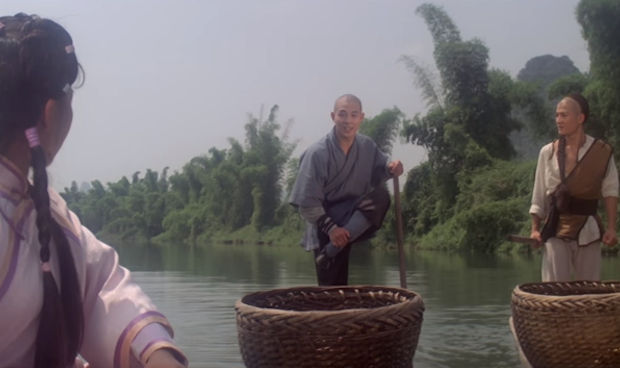
In contrast to Kids From Shaolin, the action overshadows the story here. There’s a fight every few minutes and the choreography – courtesy of Kar-Leung – is explosive. Li’s acting performance is weaker than in the first two films (perhaps the lack of a real character or perhaps Kar-Leung was just more used to a different style of performer?) but his martial arts are on astonishing form. He moves with immense speed and accuracy here, demonstrating incredible northern style wushu techniques and wielding a pole I would not like to be on the receiving end of.
The film’s mega-budget coats every frame in opulence too. Beyond the luscious scenery, the costumes and custom-built sets (including a gigantic period boat that stages the insane final fight) are beautiful. I’d go as far as to say it’s one of the studio’s most accomplished mid-80s achievements and a very respectful end to the trilogy. If you’re looking for a way in, it’s the most accessible too; more conventionally structured than 1, more action-packed than 2 and just a damn fine movie.
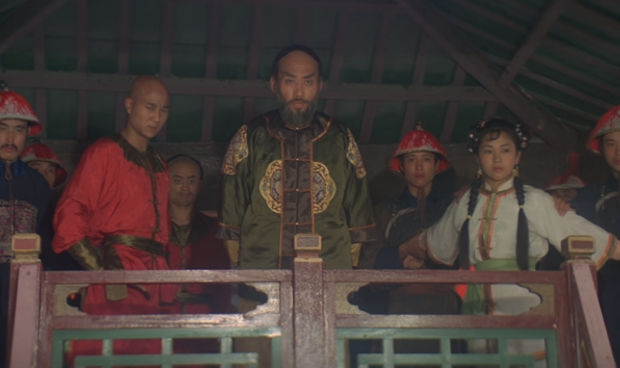
These were the only three official Shaolin Temple movies, but it’s worth mentioning – for any eagle-eyed UK fans of the series – the Vengeance Video release of a film called Shaolin Temple 4. This is completely unofficial and unrelated but not the crass cash-in you’d expect. It’s actually a (shameless) retitling of a Taiwanese grindhouse movie called Shaolin Temple Strikes Back from 1981. Directed by Joseph Kuo (Fearless Duo, Mystery Of Chessboxing, etc), it predates the original trilogy and is much lower on budget, but nevertheless, a solid watch.
Lung Siu-Fei leads the cast as a royal guard protecting a beautiful Ming Princess (Liao Li-Chun). When their escort is ambushed by the usual Manchu bastards, he flees with the Princess and they take shelter in Shaolin Temple. There, he trains with the monks under the tutelage of a drunken abbot (Mark Long – best known for playing Ghostface Killer in The Mystery Of Chessboxing) and together they prepare for the impending Manchu invasion of Shaolin.
It’s a simple story but there’s a nice bit of romance thrown in and Chen Shan makes a fun Manchu bad guy, mixing deadly charm with ruthlessness. Unlike the ‘real’ Shaolin Temple series, you can see plenty of editing tricks and sped-up film here in the fights but what it lacks in authenticity it does try to recover with energy and invention. There’s some entertaining drunken boxing on display and the final fight is an absolute massacre, fountains of blood spraying everywhere, a gratuitous giant (!) and limbs ripped off left, right and centre. It may be a scrappy little cousin but Shaolin Temple 4 is well worth a look if you enjoy the tropes and settings of the series (even though there’s no actual Mainland locations in this one).
Still, what’s obviously missing is Jet Li. Watching the original trilogy is a great opportunity to see the emergence of a superstar and features some of his finest onscreen fighting. He may have gone on to bigger and frequently better films but there’s a magic to Shaolin Temple that’s unique. With a Justin Lin 3D remake in the works, now’s as good a time as any to revisit the originals.
Let us know if you’re a fan. And if you’re new to the series, enjoy your monk-y business!

